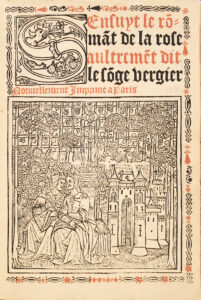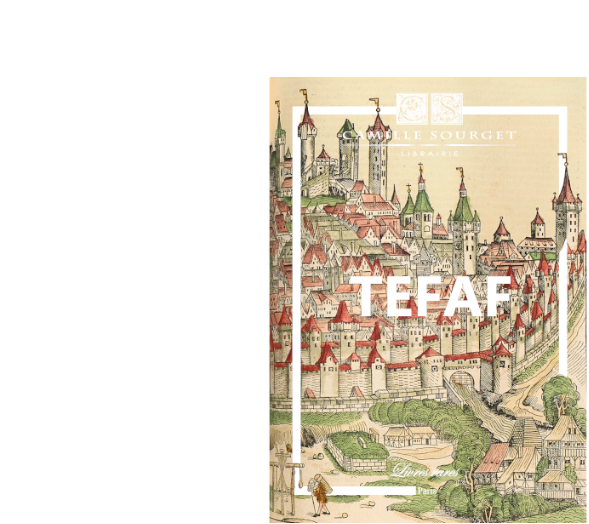/ * Style Definitions */ table.MsoNormalTable {mso-style-name:”보통 테이블”; mso-tstyle-rowband-size:0; mso-tstyle-colband-size:0; mso-style-noshow:yes; mso-style-priority:99; mso-style-parent:””; mso-padding-alt:0cm 5.4pt 0cm 5.4pt; mso-para-margin-top:0cm; mso-para-margin-right:0cm; mso-para-margin-bottom:10.0pt; mso-para-margin-left:0cm; line-height:115%; mso-pagination:widow-orphan; font-size:11.0pt; font-family:”Calibri”,”sans-serif”; mso-ascii-font-family:Calibri; mso-ascii-theme-font:minor-latin; mso-hansi-font-family:Calibri; mso-hansi-theme-font:minor-latin; mso-bidi-font-family:”Times New Roman”; mso-bidi-theme-font:minor-bidi; mso-fareast-language:EN-US;} 파리, J. Jehannot, s.d. [약 1520-1521].
소형 4o, a8, b-e4, f8, g-k4, l8, m-p4, q8, r-v4, x8, y-z4, r4, A-B4, C8, D4, E6 = (142) ff., 2열, 41행, 제목에 반복된 큰 목판, 제목의 우측 상단 모서리 복원됨. 붉은 모로코 가죽, 판 중앙에 큰 금장 꽃 문양, 장식된 제본, 컷팅의 이중 금 슬릿, 금 도금 단면. Trautz-Bauzonnet.
188 x 129 mm.
/* Style Definitions */ table.MsoNormalTable {mso-style-name:”Tableau Normal”; mso-tstyle-rowband-size:0; mso-tstyle-colband-size:0; mso-style-noshow:yes; mso-style-priority:99; mso-style-parent:””; mso-padding-alt:0cm 5.4pt 0cm 5.4pt; mso-para-margin-top:0cm; mso-para-margin-right:0cm; mso-para-margin-bottom:10.0pt; mso-para-margin-left:0cm; line-height:115%; mso-pagination:widow-orphan; font-size:11.0pt; font-family:”Calibri”,”sans-serif”; mso-ascii-font-family:Calibri; mso-ascii-theme-font:minor-latin; mso-hansi-font-family:Calibri; mso-hansi-theme-font:minor-latin; mso-bidi-font-family:”Times New Roman”; mso-bidi-theme-font:minor-bidi; mso-fareast-language:EN-US;} L’exemplaire Ambroise Firmin-Didot et Charles Bourlon de Rouvre, le seul cité par Tchémerzine (IV-227) et Bourdillon (note 4 page 52) de cette précieuse édition du Roman de la Rose imprimée vers 1520-21.
이 소장본은 첫 상태로 기록된 유일한 것으로 보입니다 : « 파리에서 인쇄됨 »이라는 문구 뒤에 숫자 XXIX가 추가되기 전.
« 제목 r. et n.는 페이지의 작은 테두리 안에 있으며: 큰 사각형 S 문자가 시작을 알리며, 4줄의 텍스투라를 덮고, 더 작은 줄과 새로운 스타일의 목판(뒤에서 반복됨)이 이어지고 있습니다. 이번에는 애인과 그의 미인이 성 앞의 풍경에 있습니다. 끝에는 J. Janot의 마크가 있습니다. 5개의 그림. »
갓티네 지방의 로리스 영주인 Guillaume II는 1239년 멜룬 성에서 갑옷을 만든 것으로 알려져 있으며, 1242년 갓티네 지방의 집행관 필리프 드 레미와 함께 중재 판결을 내렸습니다. 그러나 그의 문학적 작품은 그가 성직자였다는 것을, 어쨌든 라틴 문학(특히 오비디우스를 모방함)을 매우 잘 알고 있다는 것을 시사합니다. 그의 로만 드 라 로즈는 같은 이름의 초기 로만에서 많은 것을 차용했지만(Jean Renart에 의해) 그는 재능을 발휘하여 알레고리를(장미는 사랑하는 사람) 종교 영역에서 세속적이고 정중한 영역으로 옮겼고, 신비로운 측면을 유지했습니다. 안타깝게도, 매우 젊은 나이에 사망하여 그의 작품은 미완성으로 남았으며(4,000행).
Jean de Meung (1250-1305)은 자연 외에는 주인을 삼지 않았고 금욕주의와 사랑의 예법을 매우 싫어했던 부유한 평민이자 학자로서 그의 다소 예상치 못한 후계자였습니다. 그는 유언과 부속장 및 Giraud de Barri의 기적의 책, Veges의 기사의 책, Boethius의 철학의 위안 번역으로 알려져 있습니다. 1270-75년에 그는 Guillaume de Lorris의 미완성 로만 드 라 로즈에 대한 긴 속편(18,000 팔행시)을 작성하기로 결심하여, 충만과 다산의 철학에 기반한 완전한 사랑의 논문을 형성했습니다. 이 작품은 그에 이어지는 작품처럼 운문으로 되어 있습니다.
로만 드 라 로즈(운문)는 1538년의 마지막 판 이후 오랫동안(200년?) 재출판되지 않았지만, 많은 근대 고딕 재출판이 있으며, 그 중 1878년 파리, Delarue의 판(1938, 30 vente Fière, n° 522)도 있습니다. 또한 J. de Bonnot에 의해 1988년에 재출판되었습니다.
5개의 그림으로 장식된 귀중한 판, A. Firmin-didot 및 C. Bourlon de Rouvre가 소장한, Tchémerzine과 Bourdillon에 의해 언급된 첫 상태로 기록된 유일한 소장본.
정보 줄여보기

![Senfuyt le Roman de la Rose aultrement dit le Soge vergier. [sic] Nouvellement imprime e0 Paris.](https://www.camillesourget.com/wp-content/uploads/2023/03/lorris-titre2-T54FW.jpg)
![Senfuyt le Roman de la Rose aultrement dit le Soge vergier. [sic] Nouvellement imprime e0 Paris. - 이미지 2](https://www.camillesourget.com/wp-content/uploads/2023/03/lorris-reliuredef-XqU97.jpg)
